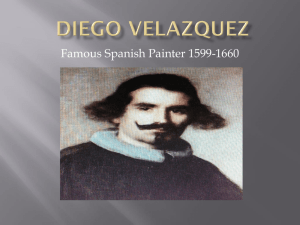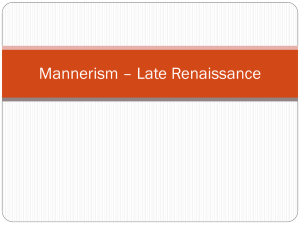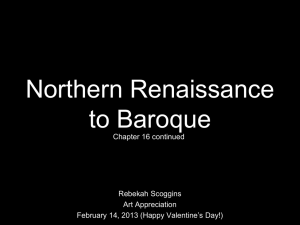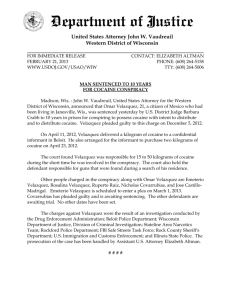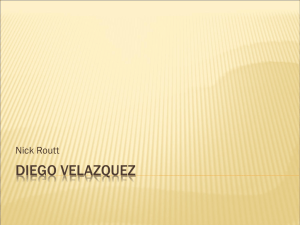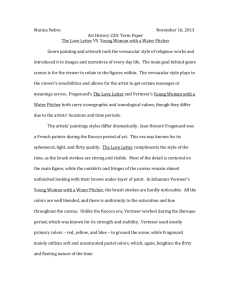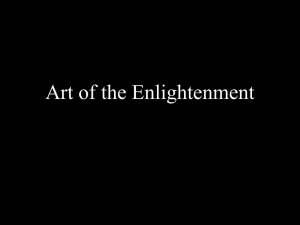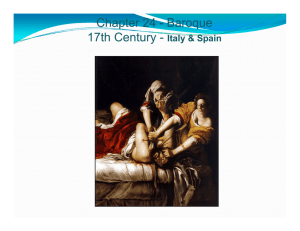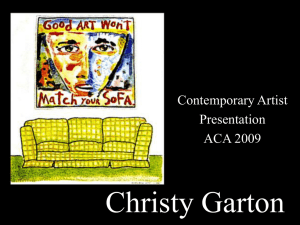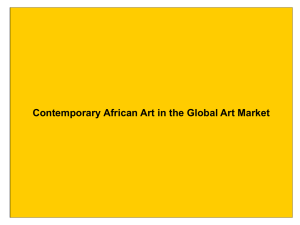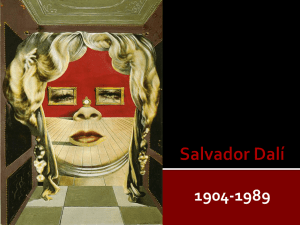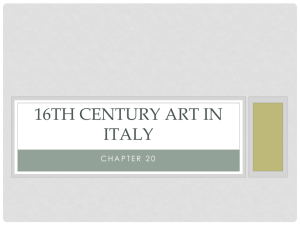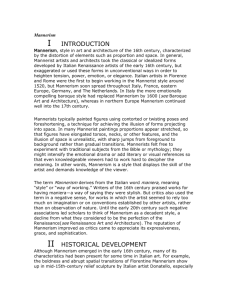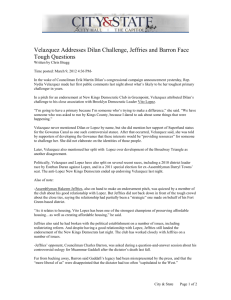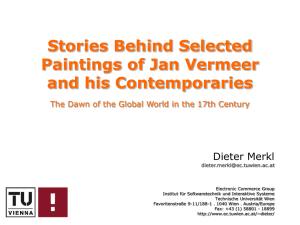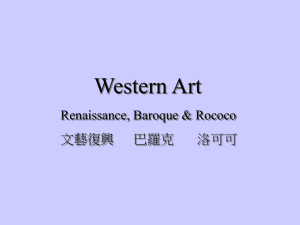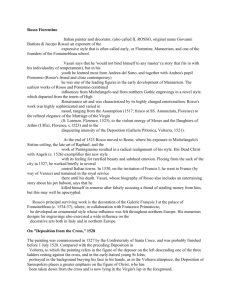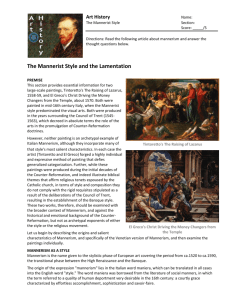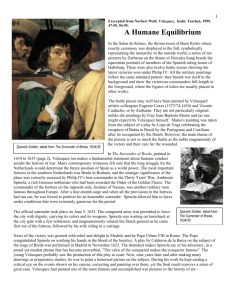Mannerism, Baroque, and Rococo - High Point Regional School
advertisement
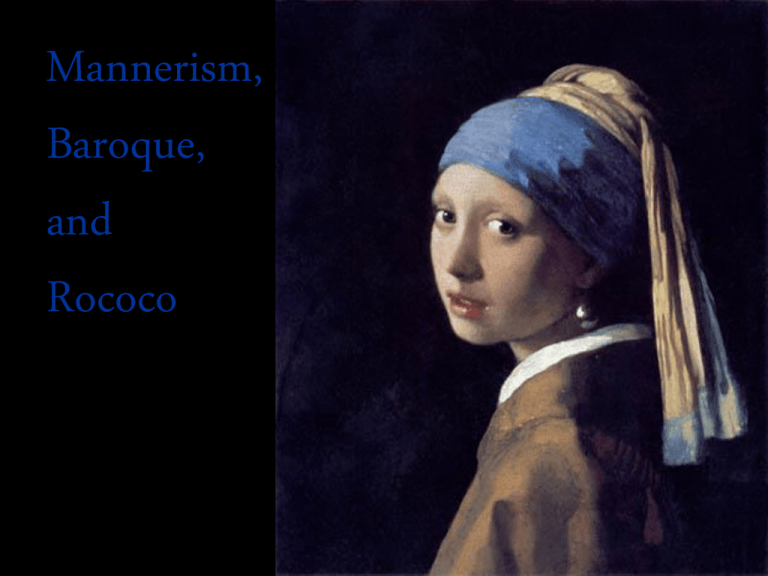
Mannerism, Baroque, and Rococo Mannerism: Rosso Pontormo El Greco El Greco, Baptism of Christ 1608-14 (210 Kb); Oil on canvas Deposition Italian artist Jacopo da Pontormo’s Deposition (1525-1528, Church of Santa Felicitá, Florence, Italy) shows the characteristics of the Mannerist style. The arrangement of the figures creates a sense of swirling movement and helps convey the emotionally charged atmosphere while the body of Jesus Christ is brought down from the cross and presented to his mother Mary. The elongated bodies and unnatural compression of space between the figures are also typical of Mannerism. Scala/Art Resource, NY Descent from the Cross In Descent from the Cross (1521, Pinacoteca Comunale, Volterra, Italy), Italian painter Rosso Fiorentino intentionally created a disturbing scenario. In this and other of his early paintings Rosso departed from the milder conventions of traditional classicism and High Renaissance art. In doing so he helped launch the style known as Mannerism in 16th-century Italy, in which artists created exaggerated scenes with attenuated figures and disturbing colors. Scala/Art Resource, NY Baroque: Bernini Rembrandt Rubens Vermeer Velazquez Gianlorenzo Bernini's "Ecstasy of St. Teresa" (1647-52), in Santa Maria della Vittoria, Rome. Marble, 11' 6" high "Beside me on the left appeared an angel in bodily form . . . He was not tall but short, and very beautiful; and his face was so aflame that he appeared to be one of the highest ranks of angels, who seem to be all on fire . . . In his hands I saw a great golden spear, and at the iron tip there appeared to be a point of fire. This he plunged into my heart several times so that it penetrated my entrails. When he pulled it out I felt that he took them with it, and left me utterly consumed by the great love of God. The pain was so severe that it made me utter several moans. The sweetness caused by this intense pain is so extreme that one can not possibly wish it to cease, nor is one's soul content with anything but God. This is not a physical but a spiritual pain, though the body has some share in it -even a considerable share." (Teresa of Avila, Autobiography, ch. 29). Rembrandt Aristotle contemplating a bust of Homer 1653 (90 Kb); Oil on canvas Peter Paul Rubens. The Three Graces. 1628-1630. Oil on canvas. Charities (called in Latin Graces) ancient Greek divines for beauty, grace and artistic inspiration, and perhaps also, in their earliest form, of powers of vegetation. They are generally said to be tree sisters called Euphrosyne, Thalia and Aglaea. Their father was Zeus, mother either Eurynome, or Hera. They are usually depicted as naked girls embracing at each other. http://www.abcgallery.com/mythology/charities. html Artist - Johannes Vermeer THE GIRL WITH A PEARL EARRING c.1665-1667 oil on canvas 18 1/4 x 15 3/4 in. http://www.essentialvermeer.com/catalogue/girl_with_a_pearl_earring.html "It is always the beauty of this portrait head, its purity, freshness, radiance, sensuality that is singled out for comment. Vermeer himself, as Gowing notes, provides the metaphor: she is like a pearl. Yet there is a sense in which this response, no matter how inevitable, begs the question of the painting, and evades the claims it makes on the viewer. For to look at it is to be implicated in a relationship so urgent that to take an instinctive step backward into aesthetic appreciation would seem in this case a defensive , an act of betrayal and bad faith. It is me at whom she gazes, with real, unguarded human emotions, and with an erotic intensity that demands something just as real and human in return. The relationship may be only with an image, yet it involves all that art is supposed to keep at bay." Edward A. Snow, , 1979 Outside Italy, one of the two principal centers of Florid Baroque painting was the studio of Diego Velazquez in Spain. His work owes much to the tradition of Caravaggio but without the intense drama. Velazquez, too, made conspicuous use of chaiaroscuro, but he avoided the extreme contrasts that made Caravaggio’s paintings controversial. Velazquez. The Maids of Honor. Madrid. 1656. Oil on canvas, 10 feet, 5 inches x 9 feet His greatest work is this group portrait of the princess with her maids of honor, painted while he was official artist to the Spanish court. The fascination with illusion and with the effects of light and dark reveals Velazquez’s links with the Florid Baroque. Are the subjects looking at the viewer, or at the artist in a mirror? Or, are they greeting the king and queen, who have just entered the room (as seen through another mirror on the rear wall)? Rococo: Tiepolo Boucher Fragonard The Chariot of Aurora Giovanni Battista Tiepolo (Italian, Venetian, 1696–1770) Aurora is shown in her chariot, accompanied by the Hours and heralded by Apollo; Time is shown on the right. Also recognizable are Ceres, with a sheaf of wheat, and Bacchus, wearing a crown of vine leaves—emblematic of summer and fall. This beautiful oil sketch was possibly a proposal by Tiepolo for the decoration of a ceiling in the Royal Palace in Madrid. Tiepolo had been summoned to Spain in 1762 by Charles III to paint the ceiling of the throne room, and upon completion of this vast fresco he made proposals for the decoration of other rooms; a ceiling of this theme was painted in the queen's bedroom in 1763 by Tiepolo's rival, Anton Raphael Mengs. François Boucher (French, 1703-1770) Allegory of Music, 1752 Oil on canvas, 26 1/2 x 30 in. Jean Honore Fragonard The Swing 1767
